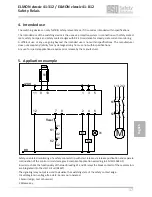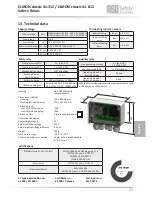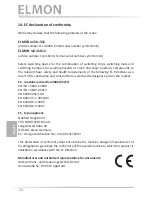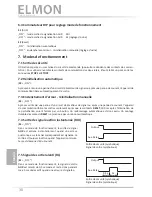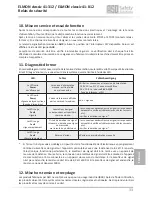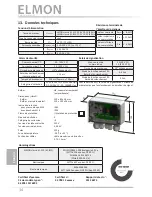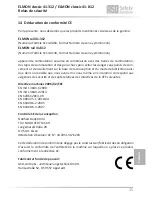
20
Safety Relais
English
8. Mechanical mounting
Polycarbonate housing with boltings for surface installation in a rough environment.
• The switching device must be mounted properly in a suitable mounting location. After the
lid has been removed, the casing can be mounted by means of four bolts.
• Do not install in the immediate vicinity of an intense heat source.
• The unit must not be operated in areas with major temperature changes.
The switching unit can be installed in any position, but in order to protect against any ingress of humidity it
should be fitted such that the cable entries point downwards.
9. Electrical connection
• The switching unit can be destroyed by connection to the incorrect terminals.
• Flexible connection leads must be secured against any shifting. The mains infeed wires must
be additionally insulated by means of insulation tubes.
• Lines that are routed in the open air or outside the switch cabinet must be protected accor-
dingly. For the unprotected external area only an appropriately approved cable may be used
(for example: rubber lead).
• The limit values stated in the “Technical Data” for the supply voltage and the switching
capability of the relay must be observed.
9
.1 Supply voltage
The supply voltage can optionally be effected by means of a mains voltage of 230 V AC 50/60 Hz
(ELMON rail 41-822: 115 V AC 50/60 Hz) or a low voltage of 24 V AC/DC. For a supply with 24 V
AC/DC the voltage must correspond to the requirements for protective low voltages (SELV). The
supply line to the switching device must be protected by means of a suitable fuse.
Never apply both voltages simultaneously !
The 230 V supply voltage must be applied to the
L1 N
terminals. For operation with 24 V, the supply voltage
must be connected to the
24 V AC/DC
terminals.
For a fixed installation a separating device must be available (for example, a main switch for the system). A
mains plug is sufficient as a separating device, if it is freely accessible.
9
.2 Connection of sensor
The sensor
with a terminating resistor of 8.2 kΩ must be connected to the
IN
terminals.
9.3 Connection of several sensors per sensor circuit
ASO sensors must not be connected in parallel.
One or several sensor
s can be connected to the signal transmitter input. For this purpose, the individual
sensor
s are connected in series in accordance with Figure 1.












